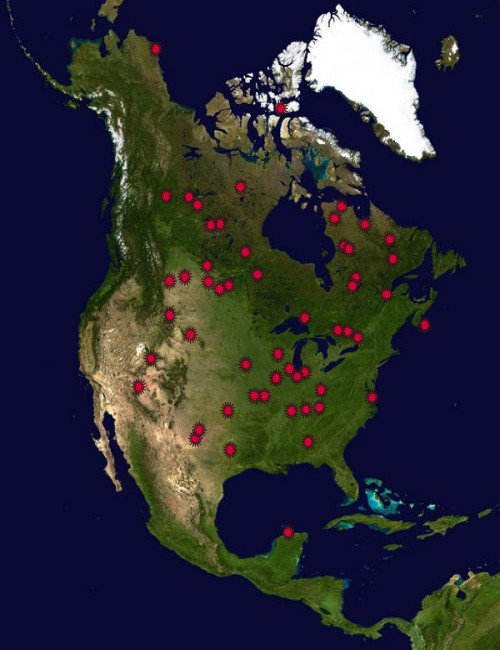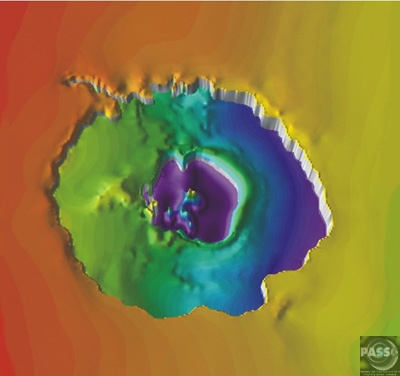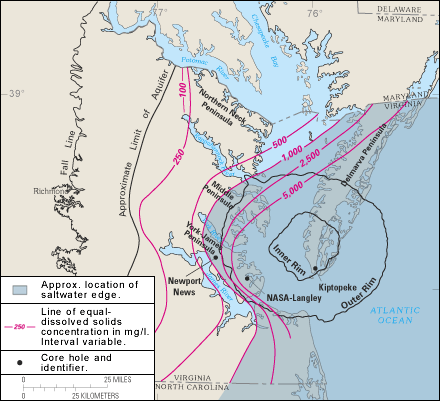|
The Enigmas on Earth Impact Craters on Earth |
||
|
North America Part Two .
|
||
|
Chesapeake Bay Crater Virginia, USA .
The Chesapeake Bay
impact crater was formed by a bolide
that impacted the eastern shore of North America
about 35.5 million years
ago, in the late Eocene epoch. It is one of the
best-preserved "wet-target"
or marine impact craters, and the second largest
impact crater in the U.S.
Continued slumping of sediments over the rubble of
the crater have helped
shape Chesapeake Bay.
Formation and aftermath During the warm, late Eocene, sea levels were high, and the Tidewater region of Virginia lay in the coastal shallows. The shore of eastern North America, about where Richmond, Virginia is today, was covered with dense tropical rainforest, and the waters of the gently sloping continental shelf were rich with marine life that was depositing dense layers of lime from their microscopic shells. The bolide impacted at a speed of many kilometers per second, punching a deep hole through the sediments and into the granite continental basement rock. The bolide itself was completely vaporised, with the basement rock being fractured to depths of 8 kilometers, and a 'peak ring' being raised around it. The deep crater, 38 km across, is surrounded by a flat-floored terrace-like ring trough with an outer edge of collapsed blocks forming ring faults. The entire circular crater is about 85 km in diameter and 1.3 km deep, an area twice the size of Rhode Island, and nearly as deep as the Grand Canyon. The surrounding region suffered massive devastation. USGS scientist David Powars, one of the impact crater's discoverers, has described the immediate aftermath: "Within minutes, millions of tons of water, sediment, and shattered rock were cast high into the atmosphere for hundreds of miles along the East Coast." An enormous seismic tsunami engulfed the land and possibly even overtopped the Blue Ridge Mountains. The sedimentary walls of the crater progressively slumped in, widened the crater, and formed a layer of huge blocks on the floor of the ring-like trough. The slump blocks were then covered with the rubble or 'breccia'. The entire bolide event, from initial impact to the termination of breccia deposition lasted only a few hours or days. In the perspective of geological time, the 1.2 km-thick breccia is an instantaneous deposit. The crater was then buried by additional sedimentary beds that have accumulated during the 35 million years following the impact. Another, smaller bolide impact site, the Toms Canyon impact crater, lies about 200 miles to the northeast, on the continental shelf off the coast of New Jersey. Having also been dated to the late Eocene, it is possible that this crater may have been formed in the same impact event as the Chesapeake Bay crater. Discovery Until 1983, no one suspected the existence of such a crater buried 300–500 meters beneath the lower part of the Chesapeake Bay and its surrounding peninsulas. The first hint was a 20 centimeter-thick layer of ejecta that turned up in a drilling core taken off Atlantic City, New Jersey, far to the north. The layer contained the fused glass beads called tektites and shocked quartz grains that are unmistakable signs of a bolide impact. In 1993, oil exploration revealed the extent of the crater. Effects on local rivers The continual slumping of the rubble within the crater has affected the flow of the rivers and shaped the Chesapeake Bay. The impact crater created a long-lasting topographic depression, which helped predetermine the course of local rivers and the eventual location of Chesapeake Bay. Most important for present-day inhabitants of the area, the impact disrupted aquifers. The present freshwater aquifers lie above a deep salty brine, making the entire lower Chesapeake Bay area susceptible to groundwater contamination. - Source: Wikipedia |
||
| FAIR USE NOTICE: This page contains copyrighted material the use of which has not been specifically authorized by the copyright owner. Pegasus Research Consortium distributes this material without profit to those who have expressed a prior interest in receiving the included information for research and educational purposes. We believe this constitutes a fair use of any such copyrighted material as provided for in 17 U.S.C § 107. If you wish to use copyrighted material from this site for purposes of your own that go beyond fair use, you must obtain permission from the copyright owner. | ||
|
|



